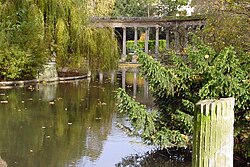Parc Monceau

The Parc Monceau is located in the 8th arrondissement of Paris , at the intersection of Boulevard de Courcelles , Rue de Prony and Rue Georges Berger . At the main entrance is a historic rotunda by Claude Nicolas Ledoux , part of the former city wall " Mur des Fermiers généraux " to delimit the tax area.
Originated in the 18th century
The park was founded by Louis-Philippe-Joseph, Duke of Orléans and Duke of Chartres, a cousin of Louis XVI, who was crowned king in 1774 . He gradually bought the land for the park and opened it in 1769 . The gardens were designed by Louis Carmontelle .
Through constant acquisitions, the garden grew to 12 hectares in 1778 and became known as Folie de Chartres (German: The Madness [of the Duke] of Chartres). Louis-Philippe was drawn to constant quarrels with the French court, e. B. with Marie Antoinette , more to London , where he became a close friend of the "Prince of Wales", who later became George IV , King of the United Kingdom .
During this time, at the latest, his preference for everything English developed, which compared to the encrusted absolutist structure in France seemed almost liberal. This explains his aim of creating an English-style garden in the center of what is now Paris. He commissioned the Scottish garden architect Thomas Blaikie , who from 1785 to 1788 gave the park a different shape, just in the English style. Because of this style, the park was an exception in France of its time. The rather playful layout, the winding paths and the rather randomly placed statues distinguish it from the more traditional French gardens.
The park also includes a number of miniature editions of architectural structures such as B. Egyptian pyramids , Chinese architecture , Dutch windmills and Corinthian columns . This could suggest that Louis-Philippe was a Freemason .
In the park there are statues of famous French personalities such as B. Guy de Maupassant , Frédéric Chopin , Charles Gounod , Ambroise Thomas and Edouard Pailleron .
After the guillotine execution of the basically liberal Bourbon Louis-Philippe in 1793 during the reign of terror of the French Revolution , the park became public property. The northern limit of the park coincided with the limit of the tax area of the city of Paris. The rotunda built by Claude Nicolas Ledoux was part of the newly built city wall " Mur des Fermiers généraux " to delimit the tax area and curb tax evasion .
Oddities
On October 22nd, 1797, the park was the location for the first parachute jump in Europe, when André-Jacques Garnerin jumped from a self-made hydrogen balloon at a height of 400 m and landed in front of a large crowd in the park.
Development in the 19th century
Declared a national commons during the Revolution, the park remained a popular location for balls and popular festivals in the period that followed. In the course of the restoration , half of the park was re-assigned to the d'Orléans family in 1852 and the other half to the French state. In 1860 the city of Paris bought the site. Half of the land was declared to be building land for new residential buildings and the Pereire brothers provided speculative edge development. This reduced the area of the park from 19 hectares to less than half. The other half was preserved as a green area by Baron Haussmann as part of this real estate operation - similar procedures also existed at the Bois de Boulogne and the Bois de Vincennes - and turned into a public park under the direction of Jean-Charles Alphand , which finally took place on August 13th 1861 by Napoléon III. opened.
In 1876, Claude Monet painted five pictures of the park, including a series of three pictures showing spring in the park. Even Hector Berlioz was a great lover of this park. The park is also described in a poem by Kurt Tucholsky and has become known to a wider public in Germany.
The park today
Today the park is a popular green oasis for residents, especially families, and the park is very popular as a playground for children.
The park can be reached via line 2 of the Paris Metro , at the entrance to the park on Boulevard de Courcelles is also the entrance to the “Monceau” metro station named after it . The chansonnier Yves Duteil wrote a chanson Au parc Monceau (album Ses 20 Plus Belles Chansons ).
In the park you can use the internet for free via WLAN access.
literature
- Robert Schediwy , Franz Baltzarek : Green in the big city. History and future of European parks with special consideration of Vienna. Edition Tusch, Vienna 1982, ISBN 3-85063-125-7 .
Web links
- Le parc Monceau. Parcs à fabriques de la région parisienne (French)
- Parc Monceau. Parisrama (French)
- Le Parc Monceau. Visions de Paris (French)
- Le Parc Monceau in Paris. Paris en 1900 (French)
Individual evidence
Coordinates: 48 ° 52 ′ 45.7 ″ N , 2 ° 18 ′ 32 ″ E


